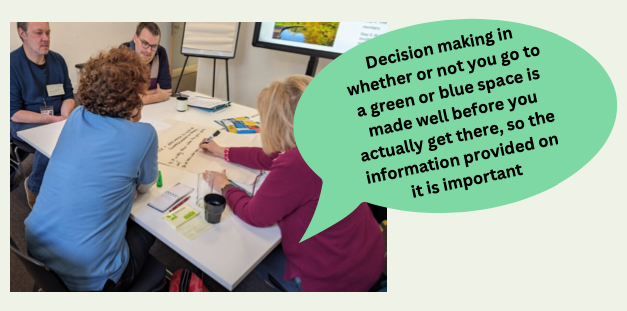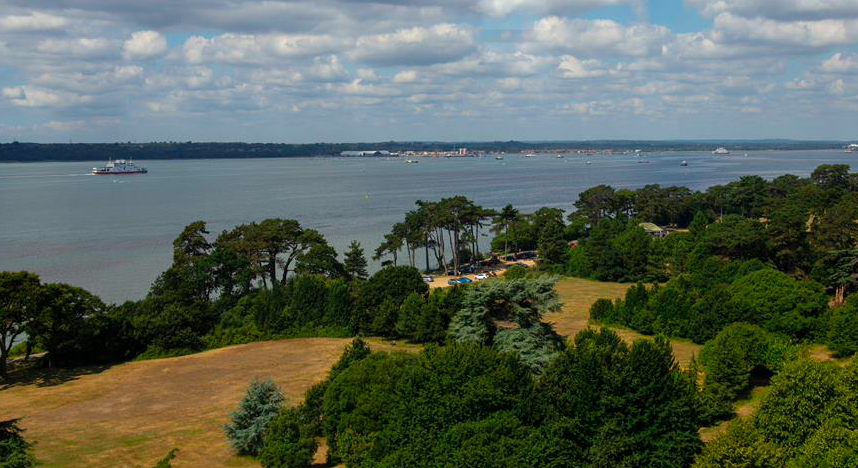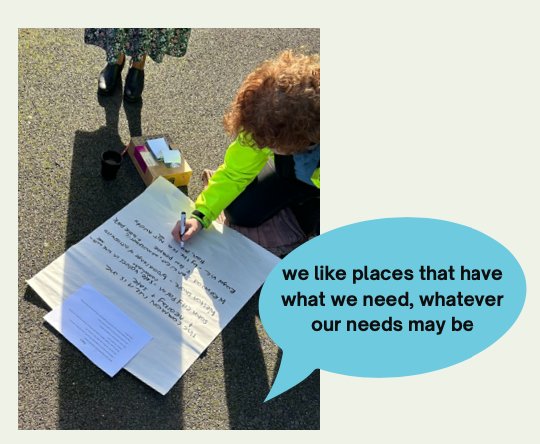
Coastal Connections Community Workshop hosted by Kate Goldie and Dawn-Marie Walker for the Coastal Connections: Systems and Synergy pilot project.
A workshop was held on 1st Feb 2024 at the John Hansard Gallery in Southampton to bring together community representatives to explore this iPACT pilot project’s perspectives and co-produce a recruitment strategy for the second phase of the Synergy work package. The strategy aims to gather views from seldom-listened to marginalised communities.
The research question
‘How to increase the use of green and blue spaces while ensuring independence and equality for all people’ should be reframed to reflect the reality that not all people are independent and equal in society, and instead focus on improving access for everyone.’
Perspectives of the project
Concerns raised about access to & use of green and blue spaces
Safety concerns
Issues including women’s safety, remoteness of spaces, water pollution, and criminal activity in some parks.
Accessibility issues
Accessibility concerns were highlighted, such as the need for wheelchair access and toilets for public use.
Travel considerations
There is a lack of safe and dry bike storage spaces in the city’s green spaces.
Many green and blue spaces in the city require a car to access.
Managing risk to wildlife
Increasing use of green and blue spaces may inadvertent damage the local environment and impact wildlife. Encouraging meaningful connections to nature should be central to mitigate these risks.

How can access and use be improved?
Welcoming and Maintenance
Participants emphasised the importance of well- maintained spaces that are inviting.
Improving Safety
Having authoritative figures present in green spaces to address concerns and deter criminal activity was proposed.
Increased CCTV.
Accessibility
Practical information about the space and available facilities should be provided in different languages.
Ideas included providing online video walkthroughs and images of spaces to improve accessibility for neurodiverse individuals.
Engaging Activities for Youth
Participants recommended promoting fun activities like geocaching to encourage young people to engage with nature.

Experiences of using green & blue spaces
What green spaces do people like and why?
The Common
Weston Shore
Westwood Nature Reseve
Southampton City Farm
St James’ Park
Mayflower Park
Many also travel to Royal Victoria Country Park & Netley Abbey outside of the city

Places perceived as safe, clean, and having a broad range of activities for families were often preferred. Other attendees valued quieter and spiritual places.
What green spaces do people not like and why?
Daisy Dip
St James’ Park
Newtown Venny/Adventure Playground Freemantle Common
Lawn Road Play Area
Safety was mentioned as a key concern, as attendees were aware of antisocial behaviour and criminal activity in many local parks. Dog poo, litter, poor accessibility, and vandals were also deterrents to enjoying green spaces.
How do people feel about blue space in the city?
Most people felt they did not live in a coastal place, citing lack of access to the sea. Despite this, some areas of the city, such as Weston Shore, allowed people to feel close to the water.
Pollution of the waterways and the lack of accessible walking routes along the water prevented people from using them. The privatization of the marina and other coastal areas were perceived as making spaces unwelcoming.
Co-Producing a Recruitment strategy
Previously, our plan for the next stage of the project was to recruit local residents through community organisations for interviews at the university.
Discussions at the workshop suggested that interviews and/or focus groups could instead take place in community spaces to improve accessibility and comfort. Ultimately, residents should be given a choice whether they want to be interviewed in person at a convenient location for them, or via phone or video call.
Hosting drop-in sessions or hiring spaces in the community were proposed as alternative options for recruitment.
Workshop attendees initially had mixed views on offering financial incentives to interviewees.
They agreed that an alternative could be providing community organisations with a budget to facilitate interviews or focus groups at their space e.g. offering lunch for attendees.
Improving the research poster
Why should people take part?
It was noted that the project goals aren’t clear on the recruitment poster. We need to be upfront about what the project will achieve, like helping decision-makers understand what communities really want.
Accesibility & design
Suggestions included improving the dyslexia- friendly design of the poster and eliminating unnecessary complexity.
Clarity & language
Concerns were raised about the naming of specific neighbourhoods e.g. ‘St Mary’s’ might not mean the same to everyone
Remove unncecesary complex language e.g. ‘systems & synergy’
Based on the workshop discussions, we will be making changes to the next stages of the project.
We propose conducting interviews and/or focus groups with residents in a community space or online/phone, as preferred. We will be working collaboratively with community organisations in the delivery of interviews and focus groups.
Overview
Attended by 9 representatives from local community organisations.
The workshop allowed the research team to develop networks within the community that will assist us in carrying out interviews for the project. The attendees of the workshop expressed interest in the project and many would like to participate in future activities (e.g. assisting with interviews).
As a result of the workshop, we were able to co-design a poster to invite members of the community to interview. We also produced a summary of the workshop discussions in pdf format.
For further inquiries or details about the project, please email Kate: k.f.goldie@soton.ac.uk